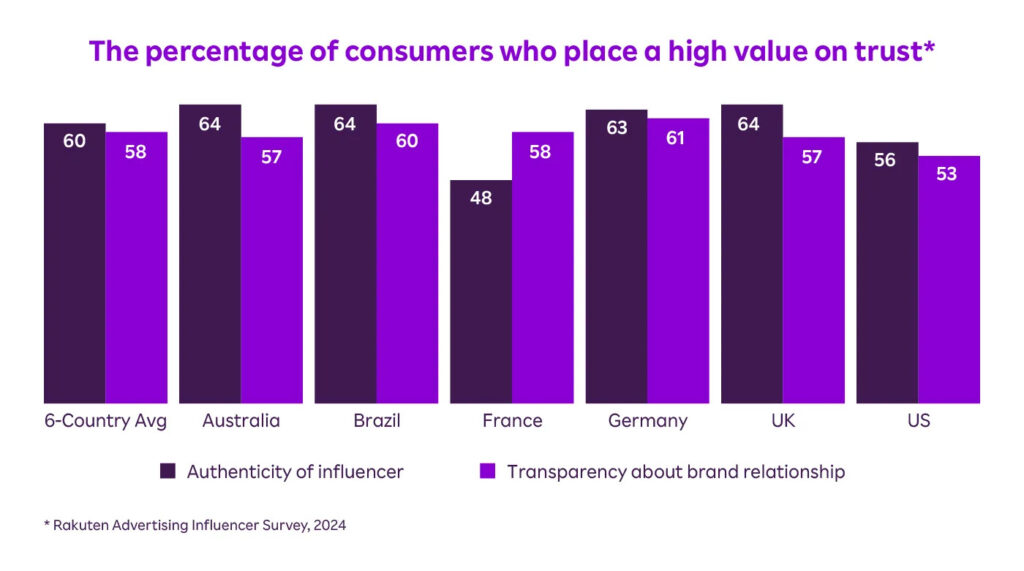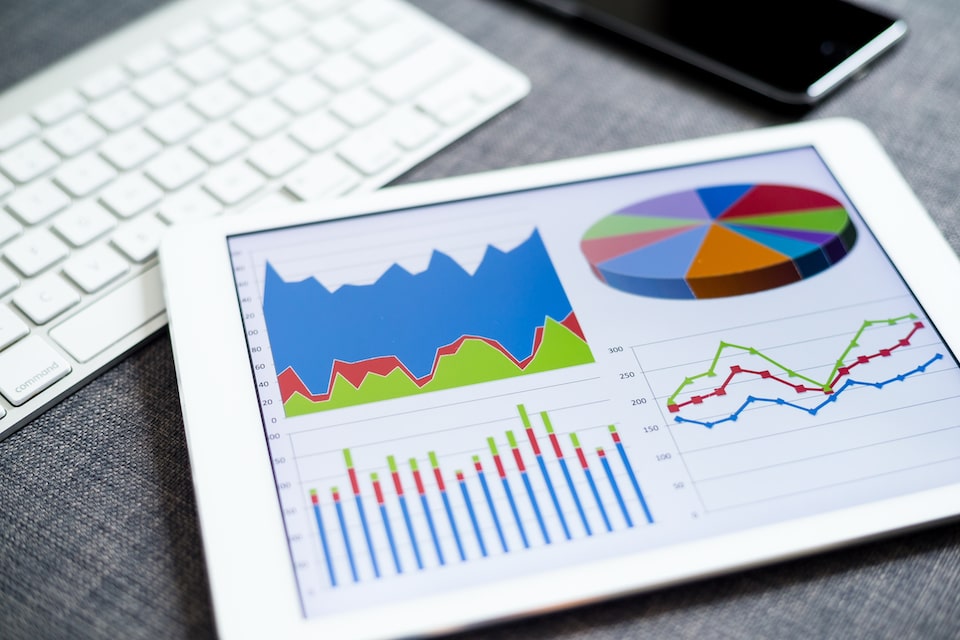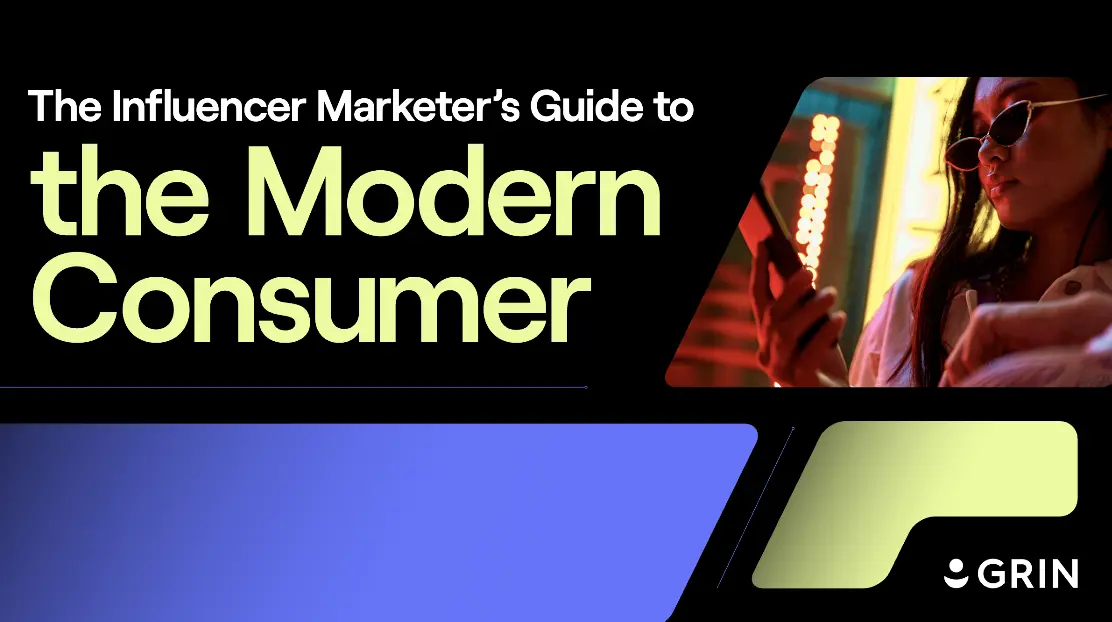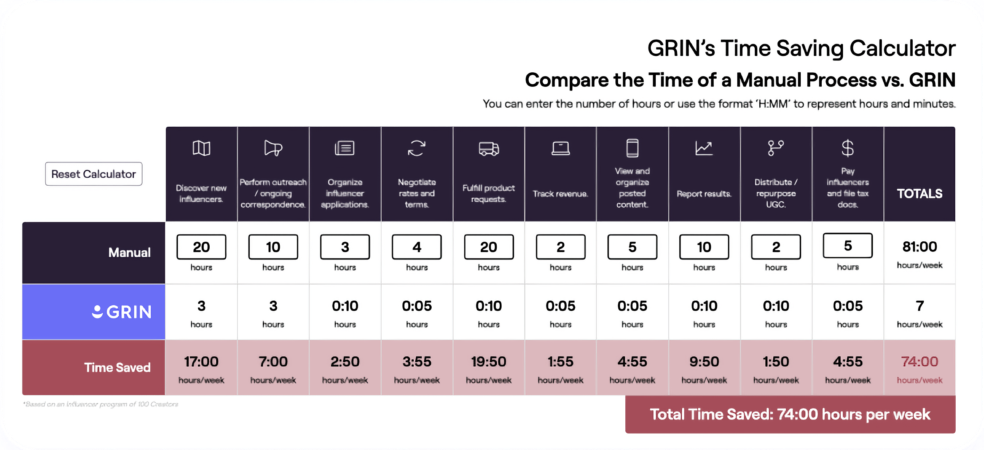20 Important Social Media Trends for 2025 and Beyond
Confused because social media is changing all the time? This is for you.
Planning influencer campaigns is hard enough without trying to keep track of changing social media trends. We’ve put together the 20 most important social media trends you need to know so you can succeed with influencer marketing in 2025.
1. Social commerce is getting way more popular.
Social platforms are finding ways to help users discover and buy products within the platforms. The social commerce industry has been growing year after year. According to Statista, the number of social shoppers in the US rose from 96 million in 2023 to around 104 million in 2025, and the global social commerce industry is expected to soar past $1 trillion in 2028.
Brands are seeing that social commerce brings more sales to their bottom line. And influencers play a major role in that because their entertaining content makes shopping on social media more fun. Social commerce is here to stay, and it’s becoming the new way to shop online.
2. People are discovering products on social media more than Google.
Because social commerce has become more popular, social media users are relying on it more and more. Gen Z consumers actually rely on social media more than Google to discover new products! This is a huge opportunity for brands to boost brand awareness.
Since so many people are using social media to discover products, influencers are more vital than ever. To get people to buy from you when they’ve never heard of your brand, you have to build trust. The great thing about influencers is that they already have audiences that trust them.
3. Online shopping is becoming more personalized.
Another effect of social commerce becoming more popular is that social media platforms keep trying to enhance the experience. This is also happening with online shopping as a whole. Online shopping platforms and social media platforms are focusing more on personalization and customization.
An example is GRIN’s Creator Shops feature, which helps brands make custom online storefronts designed around influencers. A consumer can see influencer content promoting a product, go to the storefront to buy it, then see a whole page of products recommended by that influencer. The page is owned by the brand, but customized to fit that influencer’s personality and product recs.
As social commerce becomes more personalized, creative, and interactive, these customized pages are something you’re going to see a lot more of from all kinds of brands.
4. Influencer marketing pros are using AI to make things easier.
Running an influencer campaign is challenging because there are so many moving parts. There’s also the pressure of figuring out how to make the campaign hit certain goals. The good news is, AI tools can make these challenges easier, which is why there’s a growing trend of people in the influencer marketing industry using AI.
There isn’t just one method for using AI in influencer campaigns. AI can be used for content ideas and strategy, campaign planning, content creation, analyzing campaign data, and more. The key is to try different tools and prompts to find out which methods save your brand the most time and effort and maximize results.
5. Chatbots have the answers.
One of the most time-saving ways to use AI is to implement chatbots on your social media and website. Brands and influencers alike are making use of chatbots to save time with engagement and customer service.
Manually responding to messages is a massive time drain, but if you don’t respond to everyone or you respond too slowly, people feel frustrated and ignored. Chatbots have become a trend on social media because they can instantly give people helpful info, guide them sign up for email lists, give them discount codes, and so much more. The bigger trend here is to work smarter, not harder.
6. People want content that’s authentic, transparent, and human.
In this age of AI, social media audiences are craving authenticity. That means people want content that doesn’t come across as fake, exaggerated, or manipulative. A Rakuten study found that 60% of social media users place a high value on trust in an influencer’s authenticity, and 85% will unfollow influencers who seem fake.
It’s okay for content to be imperfect. Content creators still get plenty of engagement on content that doesn’t have fancy equipment, is unscripted and unpolished, and features the creator sharing their struggles and failures. So when you’re planning influencer campaigns, remember that influencer content doesn’t have to be glamorous and flawless – it just has to be human.

7. UGC continues to be a major part of influencer marketing.
With transparency and authentic human content being so well-loved, it’s no surprise that UGC is becoming a key part of brands’ marketing strategies. What makes it great for brands is the authenticity of the content. Authenticity helps audiences trust the brand more, meaning they’re more likely to buy.
UGC is also great for influencers, not just brands. It’s a way for them to earn money, and it’s something they can do even if they don’t have an audience. UGC creators may or may not have a lot of followers. It doesn’t matter as long as they create content that a brand can use on its social channel or website. For this reason, brands have plenty of choices when it comes to UGC creators.
8. Facebook, YouTube, and Instagram are the most used platforms.
Facebook has the highest number of monthly active users of any social media platform, with 3.05 billion monthly active users in January 2025. The second most used platform is YouTube, and it has 2.49 billion monthly active users. The platform in third place is Instagram, with 2 billion monthly active users.
That said, different brands can succeed on different platforms. Every brand has to find which platforms bring the highest ROI. It’s smart to work with influencers on multiple platforms and compare results. But if you don’t know where to start, it doesn’t hurt to try one of the three most used platforms.
9. Short-form video is still extremely popular.
Short-form video continues to be a mega trend on all social platforms. TikTok is the best-known platform for it, but Instagram, YouTube, Facebook, and even LinkedIn are giving short-form videos a large part of their algorithms. This is why short-form videos can go viral and rack up hundreds of thousands of views.
The problem with short-form videos is that viewers have short attention spans. So if you’re going to take advantage of the short-form trend, remember to use words and visuals that hook the audience from the very beginning, and delete any unnecessary pauses to keep things fast-paced.
10. More influencers are becoming podcasters.
Short-form video is huge right now, but that doesn’t mean long-form content has gone out of style. Long-form content continues to be a powerful way to reach audiences, and podcasting in particular is on the rise. Content creators are continuing to make social media content, but many also create podcasts for more in-depth content.
Since podcasts are listened to by audiences who want in-depth content, podcasts create loyal, trusting fans – which is awesome for brands promoted on the show. That’s why brands are happy to sponsor podcasts. The amount of revenue generated by US podcasters increased from $0.59 billion in 2023 to $0.74 billion in 2024, and it’s projected to reach $1.33 billion in 2027.

11. Livestreaming and live shopping are hot right now.
When it comes to long-form content, livestreams are popping up all over the place. That’s because when you can watch something happening live, it comes across as more authentic than a prerecorded, edited video. A 2024 survey from Billion Dollar Boy found that livestreams are the #1 type of long-form content business owners plan to invest into in 2025.

Live shopping is another rising trend. Marketing expert Kevin P. Giang Barrera explains what makes live shopping so appealing: “Traditional online buying can be tricky, especially when you don’t know who is behind the screen. That uncertainty can make us second-guess a purchase.” Influencers using live shopping platforms like Whatnot can give viewers an immersive, trustworthy social shopping experience.
12. Sub-niche content is the way to go.
With the massive amounts of content posted online each day, getting people to see your content can be an uphill battle. Sub-niching makes it easier to get noticed. Having a niche is nice, but when your content focuses on a subcategory of that niche, that’s even better.
More brands and content creators, especially new ones with small audiences, are creating sub-niche content so their content will be seen by a narrow but enthusiastic audience. That audience will be highly engaged with the content, helping the creator eventually grow and broaden their audience. That’s why sub-niching works.
13. Brands and creators are changing the way they approach trends.
There are always new trends that pop up in social content, from songs to dances to jokes and more. Some people go viral when they make content based on a trend. But since authenticity and sub-niche content are what audiences want to see, jumping onto every random trend isn’t a winning strategy.
Brands and creators are starting to only jump onto trends that are a good fit for them. Creating content based on random, meaningless trends looks inauthentic. People know you’re just chasing views! These days, it’s better to be selective about trendy content – and even start some trends of your own.
14. Positive, ethical content does well.
Doing good happens to be a good social media strategy. Today’s social media users, especially Gen Z, want to support brands that have strong ethics. This can mean things like being environmentally conscious, promoting diversity equity, and inclusion, and creating uplifting, inspiring content.
People on social media are tired of negativity, bullying, and dishonest marketing tactics. They want to see influencers and brands make a positive impact. This was highlighted in a study from Pinterest, which has a more positive reputation compared to other platforms. The study showed that social media platforms perceived as “positive” improved brand favorability by 49%.
15. Online communities are essential.
If people want positivity, communities are the answer. People are eager to make connections with others who love the same hobbies or are in the same professional field, and this isn’t just in person. Online communities are extremely popular.
Today’s influencers aren’t just trying to get comments; they’re trying to build communities. That means people in the comments are replying to each other and giving each other tips and encouragement, which creates a sense of belonging. It also creates more loyalty to the influencer themselves.
Influencer marketing professionals are looking for communities too. GRIN’s influencer marketing community is for people who want a go-to place to ask questions, pick up expert tips, and talk about all things influencer marketing. Communities are one of the most fun social media trends right now, so if you haven’t already, you might as well join in!
16. LinkedIn and B2B content are becoming bigger parts of the influencer marketing world.
If you think influencer marketing is just B2C, think again. Business owners and executives can be influenced by content too. A growing number of B2B influencers are creating content on LinkedIn and other platforms, promoting products and services for business owners.
With LinkedIn getting into short-form video, and the enormous growth of the influencer marketing industry (more on that soon), it’s no surprise that influencer marketing now includes more B2B content. However, B2B influencer content may go beyond short-form video and typical social posts. It can also include whitepapers, case studies, webinars, and as mentioned earlier… podcasts.
17. Brands love micro and nano influencers.
Influencers with huge audiences aren’t the only game in town. Micro influencers (10,000-99,999 followers) and nano influencers (1,000-9,999 followers) continue to be highly valued by brands. Their rates tend to be more affordable than those of influencers with hundreds of thousands of followers, and they’re also more likely to have devoted, engaged followers.
In a 2025 study from Influencer Marketing Hub, “citizens and nano influencers” got the second-highest rating when social media users were asked which influencers were most likely to influence buying decisions. (The highest rating went to “industry experts and thought leaders.”) This goes to show that small influencers can have a big impact.

18. Influencers and brands are sticking together long-term.
A growing number of brands and influencers are partnering long-term instead of only doing one-off deals. Long-term partnerships benefit brands because when an influencer promotes the same brand multiple times, their audience starts to know, like, and trust that brand. And it’s nice to have a consistent, reliable partner who’s easy to work with.
Influencers like long-term deals too, because they get predictable income from a brand they love. But that’s not all. Some influencers are joining brands’ advisory boards or receiving equity from the brands they promote. When brands go the extra mile with their investments in influencers, it really pays off.
19. Social listening is more important than ever.
As the online space becomes more crowded and competitive, brands are looking for ways to step up their social listening game. Social listening isn’t just about responding to comments on your posts. It’s about knowing how social media users feel about your brand, your competitors’ brands, and your industry as a whole.
To create influencer marketing strategies that will give an ROI, you have to deeply understand how your audience feels, what kinds of content they’re most interested in, and what they aren’t interested in. The more you listen, the better results you’ll get. That’s why brands that use social listening tools have an advantage over brands that don’t.
20. The influencer marketing industry keeps growing (and growing).
Our favorite social media trend? The growth of the influencer marketing industry. The industry has grown every year since 2015, according to Statista. 2025 looks to be its biggest year of growth yet, going from $24 billion in 2024 to an estimated $32.55 billion in 2025.
Brands keep investing more money into influencers because they see how much it’s paying off. And more influencers are getting into the industry and even making it their full-time career. As a result, the influencer industry is stronger than ever. If you’re wondering if you should increase your influencer marketing budget, this is your sign.

Key takeaway: Pay attention to social media trends that will benefit your brand the most.
All right, you’ve just learned 20 trends. Now what? Don’t worry – you don’t have to memorize all of them.
Think about the goals your brand has this year and focus only on the trends that can help you reach those goals. We’ll help you stay on top of the constant changes in social media so you can use influencer marketing to reach all the goals you planned for.
























